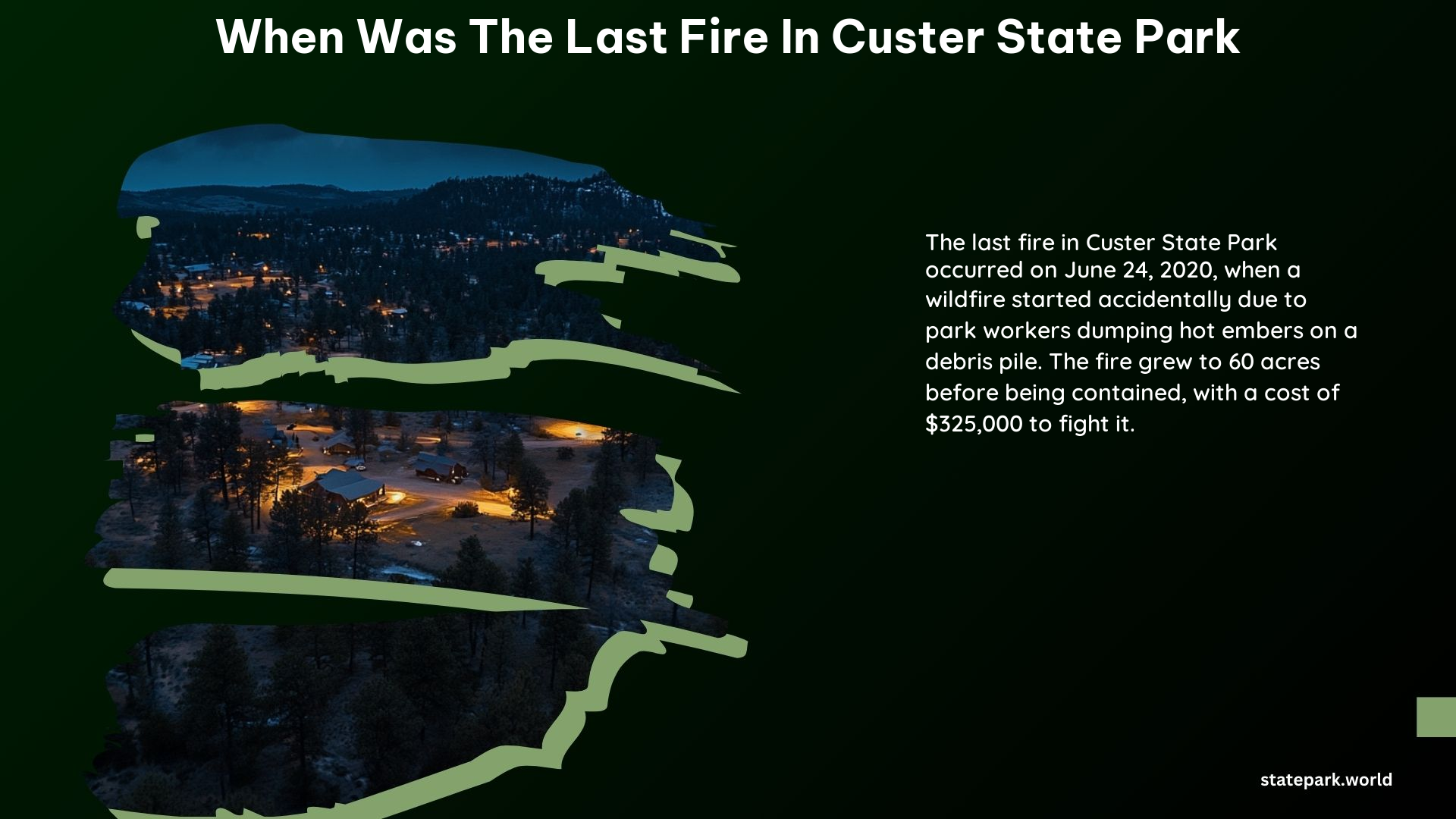The last fire in Custer State Park occurred on December 11, 2017, known as the Legion Lake Fire. This fire burned over 54,000 acres and was the third largest fire in South Dakota’s history.
The Legion Lake Fire: Custer State Park’s Largest Blaze

The Legion Lake Fire was a devastating wildfire that swept through Custer State Park in December 2017. The fire started on December 11th and quickly grew in size, fueled by strong winds and dry conditions. By the time it was finally contained on December 23rd, the fire had burned over 54,000 acres, making it the third-largest wildfire in South Dakota’s history.
Cause and Spread of the Legion Lake Fire
The exact cause of the Legion Lake Fire is still under investigation, but it is believed to have been started by a lightning strike. Once ignited, the fire spread rapidly due to the dry, windy conditions that were present at the time. The fire quickly moved through the park’s forests and grasslands, threatening nearby communities and forcing the evacuation of several campgrounds and lodges.
Damage and Impact of the Legion Lake Fire
The Legion Lake Fire caused significant damage to Custer State Park’s natural resources and infrastructure. Thousands of acres of forest and grassland were burned, and several historic structures within the park were destroyed. The fire also forced the closure of the park for several weeks, disrupting the local tourism industry and costing the state millions of dollars in firefighting and recovery efforts.
Previous Wildfires in Custer State Park

While the Legion Lake Fire was the most recent and largest wildfire to hit Custer State Park, it is not the only one. The park has a long history of dealing with wildfires, with several major incidents occurring over the past few decades.
The Jasper Fire (2000)
In 2000, the Jasper Fire burned over 83,000 acres in Custer State Park and the surrounding Black Hills National Forest. This fire was the largest wildfire in South Dakota’s history at the time and caused significant damage to the park’s natural resources and infrastructure.
The Beaver Creek Fire (2007)
In 2007, the Beaver Creek Fire burned over 12,000 acres in Custer State Park and the surrounding area. This fire was notable for its rapid spread and the challenges it posed to firefighters, who had to contend with steep terrain and limited access to the affected areas.
The Galena Fire (2013)
In 2013, the Galena Fire burned over 5,000 acres in Custer State Park and the surrounding Black Hills National Forest. This fire was notable for its proximity to the park’s popular visitor centers and the threat it posed to nearby communities.
Wildfire Preparedness and Prevention in Custer State Park
In the wake of these devastating wildfires, Custer State Park has taken steps to improve its wildfire preparedness and prevention efforts. This includes:
Fuel Reduction and Prescribed Burning
The park regularly conducts controlled burns and other fuel reduction activities to reduce the risk of large-scale wildfires. These efforts help to remove dead and dying vegetation, which can act as fuel for wildfires.
Improved Firefighting Infrastructure
The park has invested in new firefighting equipment and infrastructure, including fire trucks, water tanks, and communication systems. This helps to improve the park’s ability to respond quickly and effectively to wildfire incidents.
Public Education and Outreach
Custer State Park also works to educate the public about wildfire risk and prevention. This includes providing information on fire safety, promoting the use of fire-resistant landscaping, and encouraging visitors to be mindful of fire hazards while in the park.
Planning Your Visit to Custer State Park
Despite the risks posed by wildfires, Custer State Park remains a popular destination for outdoor enthusiasts and nature lovers. When planning your visit, it’s important to be aware of the park’s wildfire history and to take appropriate precautions.
Checking for Wildfire Alerts
Before visiting the park, be sure to check for any active wildfire alerts or closures. The park’s website and social media channels are good sources of up-to-date information on fire conditions and any restrictions or closures that may be in place.
Practicing Fire Safety
While in the park, be sure to follow all fire safety guidelines and regulations. This includes properly extinguishing campfires, avoiding the use of fireworks or other incendiary devices, and being mindful of any fire restrictions that may be in place.
Exploring the Park’s Resilience
Despite the challenges posed by wildfires, Custer State Park has demonstrated remarkable resilience. The park’s natural landscapes have a remarkable ability to recover and regenerate following a fire, and visitors can often see the signs of this recovery during their visits.
Conclusion
The Legion Lake Fire was a devastating event for Custer State Park, but it is not the only wildfire the park has faced. By understanding the park’s wildfire history and taking appropriate precautions, visitors can continue to enjoy the natural beauty and outdoor recreation opportunities that Custer State Park has to offer.
Reference:
– Custer State Park website
– South Dakota Department of Agriculture and Natural Resources
– National Park Service
